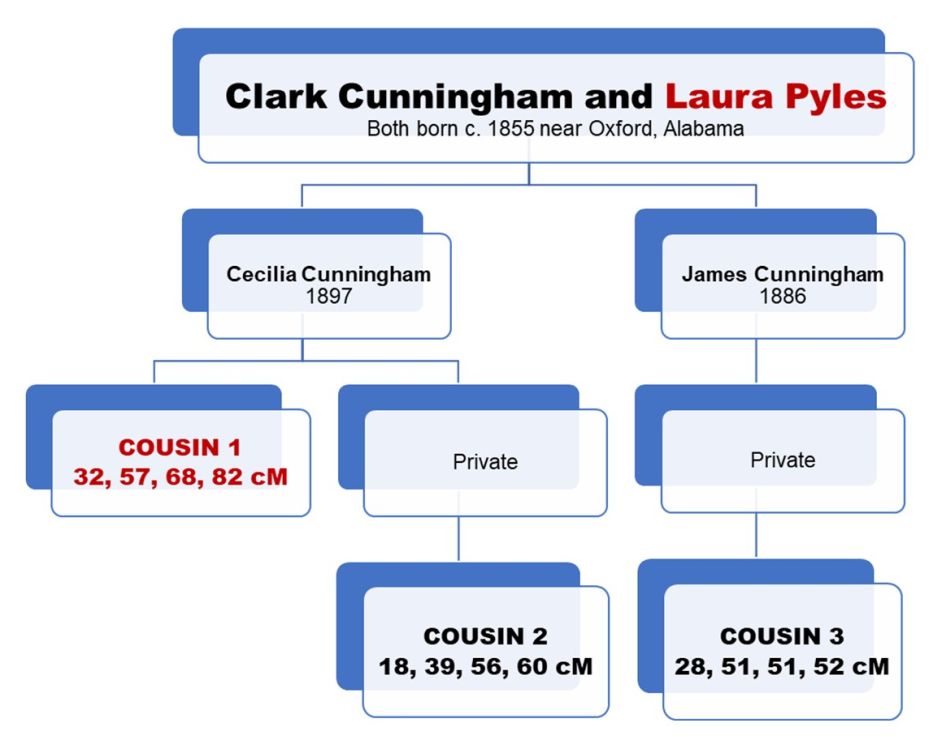
When genealogist Tierra Cotton-Kellow advised her friend to take the AncestryDNA test and to also test her uncle, she inadvertently opened a door for my research of my mother’s paternal grandfather, William “Bill” Reed (1846-1937) of Tate County, Mississippi. Let me explain. I will refer to her friend’s uncle as “Cousin 1”.
Cousin 1 is now around 90 years young, was born near Oxford-Anniston, Alabama, and his family moved to Richmond, Virginia during his childhood. He shares 57 cM over 3 segments with my mother, 68 cM over 3 segments with my mother’s sister, and 82 cM over 4 segments with my mother’s brother. He is also matching other descendants of Grandpa Bill Reed and Grandpa Bill’s sister. I soon uncovered that Cousin 1 was not-so-distantly related somehow via Grandpa Bill’s mother (name unconfirmed) from Abbeville County, South Carolina, perhaps around a third cousin or so, based on these DNA numbers. But how?
Because of my family’s relatively close match to Cousin 1 and his niece, Cousin 2, I researched my mother, aunt, uncle, and their paternal first cousin’s DNA databases and “Shared Matches” with Cousins 1 and 2 to see if any other substantive DNA matches would help to pinpoint the connection further. Turns out, the family connection is from one of Cousin 1’s maternal grandparents, Clark Cunningham or Laura Pyles of Oxford, Alabama, a suburb of Anniston. My mother, aunt, uncle, and their first cousin also share 28, 51, 51, and 52 cM with his first cousin’s son (Cousin 3), a great-grandson of Clark and Laura. He resides in Anniston, Alabama! See Figure 1 below.

How could I narrow it down further? Grandpa Bill Reed was born in Abbeville County, South Carolina and migrated to northern Mississippi shortly after slavery. His family saga was told in 150 Years Later: Broken Ties Mended. Now, I have found close connections in Alabama! Was he related to Clark Cunningham or Laura Pyles? More DNA sleuthing ensued, and I found another genetic group. See Figure 2 below.

My family is also sharing DNA with at least six descendants of Nelson Pyles of Talladega County (Oxford). Since these six DNA cousins include descendants from both of his marriages, this appears to narrow the family relationship to Nelson himself. He was born c. 1822 in South Carolina, and he was old enough to be Laura Pyles’s father. DNA strongly indicates that he was. Additionally, according to Clark and Laura’s marriage record, their marriage ceremony was held on 9 January 1881, in the home of Young Pyles, one of Nelson’s sons.
Although genealogical data statistics indicate that most emancipated African Americans did not claim the surname of their last enslavers as their own, I would be remiss if I didn’t explore the possibility that a Pyles slave-owner may have resided in the area and may have been Nelson’s last enslaver. Indeed, one was found in the 1840, 1850, and 1860 censuses.
His name was Lewis Pyles (1800-1877). He, his wife, and children were the only Pyles family in that area. According to the 1860 slave schedule, Lewis was the owner of 16 enslaved people in Talladega County. From Find-A-Grave, I learned that he had moved to Talladega County in Jan. 1833, from Abbeville County, South Carolina! Nelson would have been around 11-13 years old. Although I suspect or theorize that Nelson Pyles may have been Grandpa Bill Reed’s maternal uncle based on the DNA amounts, more research is being conducted to try to connect the dots (future blog post).
Nonetheless, while googling for more info about the white Pyles family, I stumbled on a gem – the photograph above of Nelson Pyles’s son, Young Pyles, with a group of distinguished men. The picture is labelled “Mayor and Councilmen of Hobson City, Alabama.” Hobson City is an adjacent town to Oxford and Anniston, and it is the oldest incorporated African American municipality in the state, incorporated in 1899. It is one of less than 25 incorporated African American towns remaining. The photograph shows Hobson City’s first elected officials: Young Pyles (standing, left), Peter Doyle, Jesse Cunningham, Edward Pearce, C. C. Snow, and Mayor Samuel L. Davis (seated, center).

During my eight years in Atlanta, I would often stop at Oxford-Anniston Exit 185 for gas and a snack on my drive back to Atlanta from my home state of Mississippi. I would have never imagined that a long-lost, close family member of Grandpa Bill Reed was taken to that area from Abbeville County, South Carolina during slavery. Nelson later purchased 80 acres of land in 1886, located just three miles southeast of that I-20 exit (Talladega County Deeds, Deed Book KK, p. 354). To add, his son Young helped to incorporate Alabama’s first African American town just two miles north of that exit. Without a shadow of doubt, uncovering broken family ties will often lead to fascinating, “this is a small world” findings!


Melvin, I agree with your email statement that “Genealogy Blogs Are Not Dead.” I enjoyed the local and historical details you have provided in this blog. The information may not be immediately usable by individuals because they have not made the kin and family connections. In the future, there will be persons who have direct use for all the history you have provided. Keep posting. My blog is almostdisappeared.com .
LikeLike
Blogs are typically personal case studies. Even non-genealogical blogs are very personal-based. Others’ stories and research journeys help to inspire, as well as teach how a case was solved or tackled. That’s the educational piece and reasoning behind sharing personal research stories, to include what records were available/found, what clues were ascertained, and how the history was extracted/discovered from the records. That, in my book, is the most “useful” for genealogical audiences and not necessarily for those seeking direct info related to their own families – although I hope it’s especially thrilling for those connected. But often, these cases are mostly read by non-family members. Thank you for sharing your link.
LikeLike